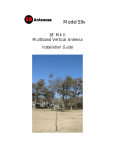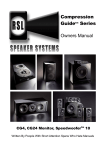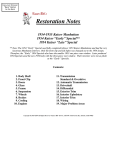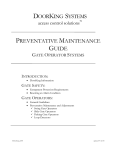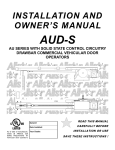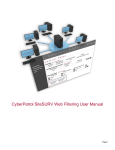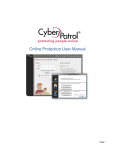Download RSL Digital Fidelity One Owner`s manual
Transcript
| SPEAKER SYSTEMS Digital Fidelity One Owner’s Manual TM TM Introduction In many owner’s manuals, the first section usually tries to make you feel good about buying the product. However, in our case, we’d rather let the performance of our speakers do the talking. For those of you who need some soothing words in order to be reassured, we present the following: (Hype:) By choosing to own the RSL Digital Fidelity One multimedia speaker system, you’ve made a winning decision! There’s no doubt that the music you love to hear is worth millions to the record companies and the artists that produce it. Yet, because of your previous speakers, you may have only been getting pennies on your musical dollar. Now, prepare to be musically rich! We know you’re going to love the RSL Digital Fidelity speaker system and having you as a happy customer makes us a winner too! Some of you are used to reading instructions that are difficult to understand. Not to disappoint some of you who expected that, we present the following: Please care of the utmost while removing all contents packages from speaker wrappings without fail. All wires that find themselves in packaging may be highly necessary to complete your installment of system speakers. Instructions such as these should be mostly concerned to you when connecting for most joyful results. You really don’t have to read all the stuff that follows if you know how to hookup a computer speaker system. If you’re like us, you hate to read instruction manuals. However, if you can stomach it, we have included helpful information to help you maximize the musical listening experience. But, even if you treat this as any other ordinary computer speaker system, you are in for a listening treat (end of hype). Quick Start Connect the two satellite speakers to the rear panel on the subwoofer, matching the RCA plug colors to the red and white sockets, and the Mini-Din plug to the socket marked “Remote.” Connect the green mini-jack cable to the (sound) source. This will typically be the speaker output jack from the sound card of your computer. If using the speakers with an MP3, CD player or radio, connect the green mini-jack cable to the headphone output of these devices. Finally, connect the AC Adaptor to the subwoofer as shown and plug into an available AC power outlet. 2 Operation Start the musical source and turn its volume up to approximately 60%, if possible. Press the round power button on the speaker base and observe that the green LED is lit. This indicates that the speakers are operating. Adjust the speaker volume to the desired listening level using the Up/Down controls on the satellite speaker base. Check that sound is heard from all Speakers. Note: If you would like to have the volume control on the right side, simply slide both speakers forward off the bases and switch them. Troubleshooting Symptom No sound is heard from either speaker Possible Cause/Solution Make sure unit is plugged into an AC outlet that has power. Unit not turned on. Make sure power button is pressed on speaker base and that green LED is lit. Volume is too low - press ^ (up arrow) button on speaker base. Audio cable (green plug) is not plugged into a correct sound source. Sound source is not working or output level is very low. Turn up volume at sound source. Sound is heard from only one speaker Speakers are not connected together properly. Connect RCA cables properly-see diagram. Be sure to turn the Power off on your speaker system when unplugging or plugging cables! 3 Connection Diagram Specifications Dimensions: Each satellite including stand: W: 3 ¾”, D: 5 ¼”, H: 6 ¼” Removing satellites from stands reduces height to 4 ¾”. Subwoofer: W: 7 ¼”, D: 10 ½”, H: 11 3/8” Add 1 ½” depth for the plugs at the back. Cable lengths are 78-80” Weight (not incl. Box) 16 ½ pounds. Note: What follows are true hi-fi power ratings. Others, who may be unethical, might rate the system at a ridiculous 600 watts. RMS (Honest) Power (Satellite) 5W x 2 RMS (Honest) Power (Subwoofer) 15 W Signal to Noise Ratio 90 db Frequency Response (overall) 45 - 18K Maximum SPL 98 db Total Harmonic Distortion Less than 1% Amplifier Sensitivity 300 mv Dynamic Headroom Greater than 2db 4 Company Information Who is RSL Speaker Systems and Rogersound Labs? RSL Speaker Systems started in 1970. Back then we all had long hair. Now, we’ll settle for any hair! Over the years we have produced many models of speakers that have been used in homes, recording studios, and radio stations. We also operated retail stores under the name of Rogeround Labs, where we emphasized knowledgeable salespeople, no pressure selling and great deals. The company was sold in 1989 and unfortunately went out of business in 1992. The original owner repurchased the rights to the names and trademarks of Rogersound Labs and RSL Speaker Systems (no other assets, debts or obligations). Fast forward to the present. With the advent of MP3 and CD burners, music on your computer offers many advantages over the traditional stereo system (we’re not referring to home theater or audio-video systems, only music systems). For example, you can store an entire music library on hard disk and easily program it for hours of music. You pay to download songs (legally) and can effortlessly burn CDs. You can even get an inexpensive FM stereo radio that can plug in to a USB port. Who knows, music on computers may become the preferred way of listening. The RSL Digital Fidelity One speaker system has been specifically engineered for accurate musical reproduction when used with various multimedia devices. That not only includes PCs and notebook computers, but personal CD players, DVD players, MP-3 players, TV’s, etc. As such, the design principles rely on the art of audio speaker design that have been refined over the past 50 years. This is a different design approach from the typical computer speaker. We feel clarity and accuracy is a lot more important than just being able to play loud. Additional Setup Info Setting up the RSL Digital Fidelity One speaker system is as easy as setting up any other computer speaker system. We do, however, suggest you choose a time to set it up when you can relax. An enjoyable musical experience is in store for you. Pick a time when you can put your everyday stresses on hold. Perhaps, put on some comfortable clothes, grab a glass of your favorite beverage and choose a favorite musical selection. (Please make sure the song contains clean language, after 5 all your speakers are very young). General Placement and Room Acoustics Placement of speaker is very important. The RSL Digital Fidelity One is a 3piece system with a separate subwoofer (containing the amplifiers) and two small “satellite” speakers. In most audio systems, there is a left and right speaker only. Each of these speakers is supposed to reproduce the entire audio range from the bass to the treble. Yet, the best position for a speaker to reproduce bass is very different from the best position for the middle and treble notes. Because the RSL Digital Fidelity One is a 3-piece system, each element can be placed separately for best sound without compromise. RSL Digital Fidelity One Speakers with your computer Perhaps the most common use of the RSL Digital Fidelity speaker system will be with your computer. This is very similar to the near-field monitoring that professional recording engineers use when they mix in recording sessions. With near-field monitoring, smaller monitoring speakers are placed on the recording console a short distance from the engineer. 6 There are several advantages to using the RSL Digital Fidelity One in this manner. First, proper placement becomes easier. The angle between you and the left and right speakers is usually close to optimum (somewhere between 60 and 90 degrees). Due to the superior imaging qualities of the RSL Digital Fidelity One, the satellite speakers can be placed a bit further apart without the apparent “hole” in middle that most speakers leave. We recommend that you place both satellites at the same height and not against the wall. Make sure they face the same direction. The front of the grilles should be slightly in front of your monitor. Both the satellites and subwoofer are magnetically shielded. Using the RSL Digital Fidelity One speaker system in a near-field situation such as with computers tends to minimize the acoustical problems of the room. Optional Reading About Room Acoustics I really don’t know why we’re calling it “optional reading.” After all, isn’t this entire owner’s manual optional? Nobody’s going to look over your shoulder to see if you’re reading any of it. As a matter of fact, if you call us with a problem, we’re not going to say, “Aha, you haven’t read your owner’s manual. Shame on you!” More than you probably want to know about Room Acoustics Room acoustics have a major effect on sound quality. If your room has good acoustical qualities, even inexpensive speaker systems can sound great. If your room has poor acoustics, expensive speakers can sound lacking. The dimensions of the room and the amount of sound-absorbing material in it determine the acoustics. Obviously, you can’t do a heck of a lot about the dimensions in your room. The dimensions primarily affect the bass response. The absorptive material (which you can do something about) in your room affects the middle and treble frequencies. The materials that can absorb sound reflections include carpet, upholstered furniture such as sofas, chairs and pillows, as well as drapes and wall treatments. A room with poor acoustics can generally sound harsh, tinny or hollow. A solution would be to add more absorptive materials. And, if you can’t do that, why not invite a lot of friends over and tell them to wear thick jackets or heavy sweaters (could be a problem if you live in a nudist colony). 7 The RSL Digital Fidelity One speaker system as the heart of an audio system The RSL Digital Fidelity One speaker system can be used with audio components to form a great audio system. People who are into high quality audio systems will often place the satellites of a 3-piece system on tall speaker stands as show in the above illustration. This is the ultimate way to enjoy your RSL Digital Fidelity One speakers. When the speakers are further away, the sonic image will tend to be larger and more lifelike. Also, you will hear better bass response as the greater distance will allow the longer wavelengths of the lower bass frequencies from the subwoofer more room to propagate. If possible, place the satellites on tall stands. Optimum height would place the speakers at about the height of your ears. The stands should also be away from the wall by at least a foot or two and away from the sides of the room. The satellites can also be angled inwards in order to point towards the listener. A bit of experimentation is in order here. The optimum situation would be where no other object is near or against the satellites. Any object near the speakers will affect the imaging and response of the satellites. Of course this is not always possible. Tall speaker stands are widely available from most audio stores and Radio ShackTM. They sometimes run about $40-$60 per pair. As indicated above, placement of the subwoofer is quite different than placing the satellites. The amount and character of the bass can be greatly affected by 8 placement. The more wall and/or floor surfaces the subwoofer is close to, the greater the bass. Placing the subwoofer on the floor will add to the bass. Placing it both on the floor and against a wall will add even more bass. Placing it in a corner where it is on the floor and near 2 walls gives yet even more bass. The subwoofer doesn’t have to be between the satellites. Place it anywhere you’d like. Bass is essentially non-directional and difficult to tell where it originates from. The subwoofer also contains a level control on the rear for further adjustment of the level of bass. You may find that when you place the woofer in a corner of your room, the length of the cables may be too short. Fear not! All the cables used in the RSL Digital Fidelity One speaker system are pretty much standard. Unlike some greedy companies that make their cables special so that you’ll have to order more from them, ours can pretty much be obtained from your local computer store or Radio ShackTM. To extend the satellites from the subwoofer you will need a pair of RCA extension cables (female on one end-male on the other). You will also need to extend the cable that controls the volume and power from the satellite to the subwoofer. This is a standard “PS-2” keyboard extension cable. PS-2 plugs are used for most computer keyboards and mice. 9 Summing Up (The end of these boring instructions is near!) As previously mentioned the RSL Digital Fidelity One speaker system is designed not just for your computer, but other components as well. These include personal CD players, MP3 players, Minidisc players, FM Radios, cassette players, and TV sets. For example, a portable stereo radio’s headphone jack can feed the RSL Digital Fidelity One speaker system . The result is great sounding FM stereo. The same goes for an inexpensive personal CD players as well as the other sources mentioned above. You can even use a switcher to connect multiple sources into the speakers. RSL’s exclusive DLP circuitry helps to make the RSL Digital Fidelity One speaker system compatible with all the different output levels of these devices. The end result is an inexpensive audio system capable of amazing sound reproduction that is also energy efficient. Enjoy! 10 THIS PAGE ACCIDENTALLY LEFT BLANK. (Please email us if you have any ideas of what should go here). Limited Warranty Rogersound Labs, LLC warrants the RSL Digital Fidelity One speaker systems to be free from defects in original materials and workmanship in the course of normal and reasonable use for a term of one (1) year from the date of purchase. This warranty is the exclusive and only warranty applicable to RSL Digital Fidelity One speaker systems, by Rogersound Labs, LLC, and RSL Speaker Systems. Any other warranties, either expressed or implied, are invalid. Neither Rogersound Labs, LLC, nor any authorized reseller is responsible for any incidental damages incurred in the use of the speakers. (This limitation of incidental or consequential damage is not applicable where prohibited by law.) Rogersound Labs, LLC’s obligation under this warranty does not apply to any defect, malfunction or failure as a result of misuse, abuse, improper installation, use with faulty or improper equipment or the use of the RSL Digital Fidelity One speaker systems with any equipment for which they are not intended. The terms of this warranty apply only to RSL Digital Fidelity One speaker systems when such speakers are returned to the respective authorized RSL Speaker Systems reseller where they were purchased. Proof of purchase will be required. Under the terms of the warranty, the original consumer purchaser has certain legal rights and there may be other rights which can vary worldwide. Rogersound Labs, LLC 26500 W. Agoura Road Suite 102-571 Calabasas, CA 91302 USA If you are experiencing a problem with your speakers, please check our the support section on our website before contacting us. You may find the solution there www.rslspeakers.com Email: [email protected] TM













